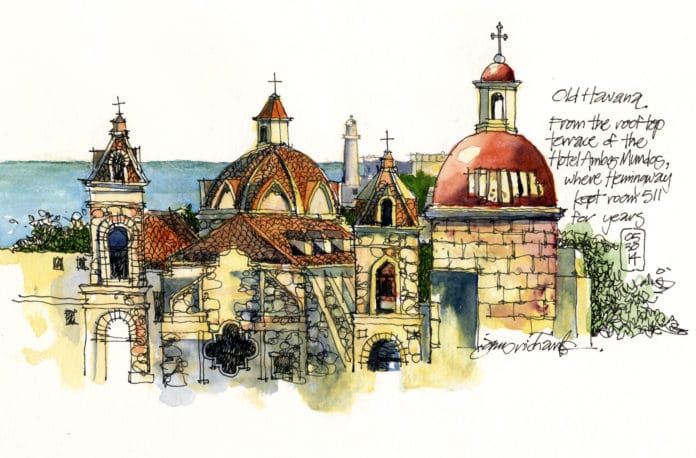James Richards has stalked Ernest Hemingway, fascinated with the creative process that led the famous writer to pen works such as The Sun Also Rises, A Farewell To Arms, For Whom The Bell Tolls and The Old Man And The Sea.
Richards is an associate professor at the University of Texas at Arlington’s School of Architecture and co-founder and principal of TOWNSCAPE Inc., an urban design consultancy in Fort Worth. But he also is a sketcher, practicing that craft in travels to 43 countries and as a teacher at design sketching workshops across the United States and around the world.
So when the opportunity to visit Cuba on a Hemingway tour came up last year, he and his wife, Patti, jumped at the chance.
“I draw wherever we go,” Richards said. “I was the only person on this particular tour drawing, and toward the end, the Hemingway museum director said, ‘Would you like to do an exhibition at our museum?’ And, of course, I jumped on that.”
Richards was in Havana over the past weekend where his exhibition of watercolor sketches called “Hemingway’s Cuba” was on display through June 22 at Finca Vigia, Hemingway’s home outside Havana, as part of the Havana Arts Biennial. He spoke at the International Hemingway Colloquium about the exhibition.
Participation by American artists at the festival is rare. There are plans underway to show the same exhibition in Fort Worth in the future.
On that first trip to Cuba, Richards also caught the attention of officials with Marimar Travel & Tours, who called a couple of months later and asked whether he would lead a sketching tour to Cuba. He recently returned from that weeklong tour, in which he hosted and conducted sketching workshops for mostly architects, landscape architects, urban designers and artists.
He has long been a Hemingway fan and student. “I’ve pursued a creative career now for almost 40 years, and it was interesting to see how other creative people worked. Hemingway, to me, was always unique with the way he collected experiences in places that were the grist for his work,” Richards said. “You couldn’t write about these places without seeing these places, and you couldn’t write about bullfighting or war without experiencing those types of things.”
Hemingway was born in 1899 and served in World War I. He was a foreign correspondent before he became a famed author. He visited and lived in Cuba throughout his life. He committed suicide on July 2, 1961, in Ketchum, Idaho.
So visiting Hemingway’s haunts in Cuba was a draw for Richards. “I just felt compelled, kind of pulled there, for decades,” he said. “I’ve always been in love with Caribbean culture. The music is like musical heroin – you just can’t get enough of it.”
But there were other reasons to visit the island as well. He did urban planning, downtown revitalizations and streetscape makeovers for 35 years.
“For somebody who’s interested in any of those types of things, Cuba was always irresistible as a time capsule. Architecture, transportation – it’s just like somebody closed the door in 1959, and nothing changed,” he said. “There’s some Soviet architectural changes and a few things like that, but by and large, its just a fantastic opportunity to go back in time and see what that Cuban Caribbean architecture was all about at that time, and also see what happens when it’s allowed to deteriorate over 50 years.”






